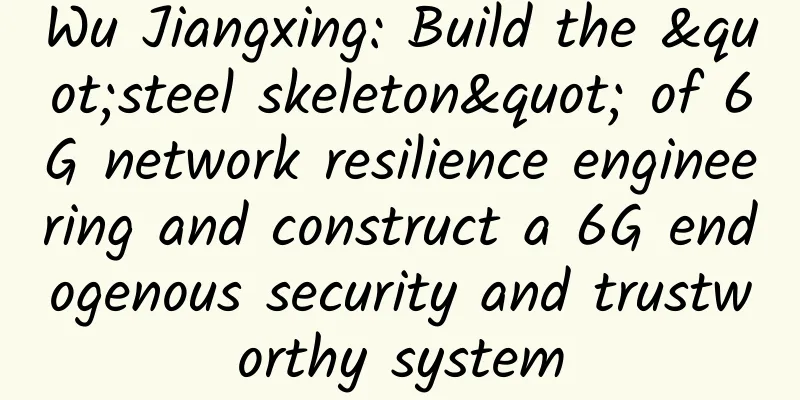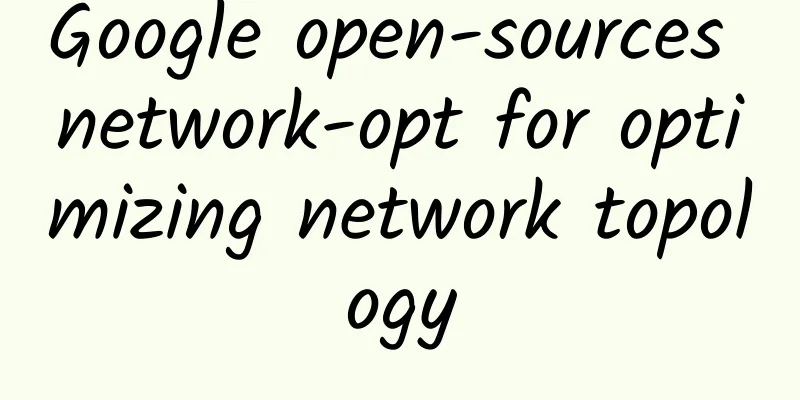Wu Jiangxing: Build the "steel skeleton" of 6G network resilience engineering and construct a 6G endogenous security and trustworthy system

|
March 14th news: As an important supporting technology for intelligent connected infrastructure after 2030, 6G will change the world. This change is a constructive and inclusive change. It uses the power of scientific and technological innovation to bridge the digital divide, connect information islands, take into account the demands of all parties, and empower sustainable development with intelligence. As an industry event in the 6G field, the third "Global 6G Technology Conference" will be held in Nanjing from March 22 to March 24, 2023. On the eve of the conference, Wu Jiangxing, academician of the Chinese Academy of Engineering and director of the National Digital Switching System Engineering Technology Research Center, said in an exclusive interview with C114 that 6G, as an important supporting technology for intelligent network infrastructure, will provide key services for the world where humans, machines and objects are highly integrated. It requires that 6G security must pay special attention to the broad functional security of 6G networks, such as flexibility and trustworthiness, on the basis of traditional information security confidentiality, integrity, availability and privacy protection. Academician Wu suggested that my country's 6G research should continue to maintain its advantages in technologies such as intrinsic security and multimodal networks, build a "reinforced skeleton" for 6G network resilience engineering, construct a 6G intrinsically secure and trusted system, demonstrate Chinese wisdom to the world, and provide Chinese solutions; at the same time, it is necessary to advance the verification of 6G technology, actively promote 6G international standardization work, and seize the high ground in the 6G national strategic competition. Multimodal network environment accelerates the construction of a new ecosystem of diversified technology systems for 6G networks Diversified 6G network services require a diversified 6G network technology system ecosystem to support them. Academician Wu pointed out that "the coordinates of the future network development paradigm have shifted to a multi-dimensional, multi-dimensional, symbiotic and integrated environment, and new practice norms must revolve around how to use an integrated environment to support the engineering implementation of diversified or diverse network systems." At the network layer, it is necessary to develop "network of networks" technology to build an "open, transparent, unified, flexible, intelligent, and securely isolated" network infrastructure that can support the "rapid growth or deployment" of various application network modes and related services, as well as a healthy and sustainable technology and industry ecological environment. Academician Wu called it a multimodal network environment. Different from the research coordinates of the traditional network development paradigm, the multimodal network development paradigm focuses on "how to provide an integrated, sharable, and secure network infrastructure resource environment for various types of application network modes", which can fully stimulate the "free" innovation vitality of the application network system and related services, and accelerate the construction of a diverse ecological environment for application network modes. Compared with the existing Internet, the multimodal intelligent network environment supports the rapid deployment (or withdrawal) of various network modes (network technology systems) in the form of "application plug-ins", which can solve the maturity barrier problem of "the inherent nature of the current single technology system commercial operation network naturally excludes or rejects the experiment and demonstration of the emerging network system, and the specially built new test network cannot obtain the verification of real application scenarios", greatly reducing the threshold for the rapid entry of emerging network technologies and applications into the market, and promoting the formation of a "three-in-one" coordinated development pattern of network technology innovation, industrial development, and market application. This can fundamentally change the network system with first-mover technology advantages and the operators who are burdened with huge upfront investment, and inevitably fall into a closed self-evolution or homogeneous development model of "dressing up and packaging and carrying", consciously or unconsciously rejecting or "dwarfing" the introduction of emerging application network modes. More importantly, based on PINE, a new ecological environment for the integrated development of network modes, business applications and network infrastructure can be created. The diversified wireless air interface technology system ecology is similar to the diversified network system ecology. Academician Wu believes that building a multi-modal wireless air interface support environment on the wireless side, separating the air interface technology system from the support environment, and being compatible with and supporting the continuous evolution of diversified air interface technology systems on this support environment are possible future development directions for 6G wireless air interfaces. The multi-modal wireless air interface support environment, based on the dynamic regulation of the wireless environment and the dynamic definition of the air interface technology system, elementizes the natural environment resources, environmental regulation resources, and air interface baseline resources in the wireless air interface, and forms the so-called "environment of environment" through software-defined combination, that is, the artificial environment on the natural environment, just like the slices in the network, which can be regarded as customizable air interface slices to support the symbiosis and coexistence, evolution and transformation of diversified wireless air interface system modes for diversified application scenarios, such as the three major air interface modes of 5G/B5G, and the future 6G air interface mode. The endogenous security core supports the new 6G security system with high availability, high reliability and high trustworthiness Academician Wu believes that as an important supporting technology for intelligent network infrastructure after 2030, 6G will realize the large-scale application of various intelligent technologies, which contains "triple security risks", which are manifested as common security issues, individual security issues, and general functional safety issues. The root cause is that the "loopholes" and "backdoors" in cyberspace have spilled over into physical space and cognitive space, which will not only endanger the safety of people's lives and property, but also affect the safety of critical infrastructure and social security and stability. To achieve global commercial use, 6G must break through the barriers of general functional safety. Only by achieving security and trustworthiness can the healthy and sustainable development of 6G technology be promoted. If the technology cannot effectively suppress cyber attacks based on "loopholes" and "backdoors", national security issues will become an insurmountable gap in the development of 6G. At present, my country has made breakthrough progress in the field of 6G security, especially in the field of endogenous security, which has been recognized globally. The theory of endogenous security solves the global problem that network security cannot be quantified and cannot be quantified, so that everyone can have a "bottom line" on network security performance. 6G, with its unique endowment of endogenous security technology, will face the "triple security risks" of the intelligent era, break through barriers with innovative ideas of high trust, high reliability and high availability, and contribute Chinese wisdom and solutions to the interconnection, sharing and governance of global cyberspace. Academician Wu pointed out that 6G must change the traditional development paradigm that relies on a few iconic access technologies, "decoupling" the network from the business, and "patch" security measures based on prior knowledge, and open up a new development paradigm of endogenous security. The development vision of the endogenous security paradigm is to support the integration of network communication and network security based on system construction technology, and provide an integrated solution for the generalized functional safety threats caused by the interweaving of functional safety and network security in the digital physical environment, forming a 6G practice specification with high availability, high reliability, and high trust. Since its proposal, the endogenous security paradigm has received widespread attention in the industry. The concept that 6G needs to take into account both network communication and network security, and that functional safety and network security need to be jointly designed has been increasingly recognized. Academician Wu's team released the "6G Intrinsic Security Trustworthy Technology White Paper" at the Second Intrinsic Security Development Conference, proposing that 6G must have built-in security genes, based on the structuring, customization, intelligence and automation of the 6G Intrinsic Security Trustworthy Technology System, develop system construction technologies such as mimicry defense, network and wireless intrinsic security, strengthen research on security technologies such as artificial intelligence security, quantum-resistant cryptography, confidential computing, and blockchain, and realize four major security pillars, including intrinsic security communications, intrinsic network resilience, collaborative privacy protection, and diversified supply chain security. The white paper constructed a 6G intrinsic security trustworthy system for the first time, integrating non-functional characteristics such as network security and network resilience with various functional characteristics of 6G in the network system architecture, and explored and opened up a new 6G paradigm of high availability, high reliability, and high trustworthiness to deal with broad functional safety threats. Intrinsic security enables 6G network resilience and ensures the robustness and continuity of 6G services or businesses Academician Wu believes that the reason why cyberspace security issues are rampant today is related to the inherent structural genetic defects of computer science and technology, as well as the fact that humans have long "selectively ignored" the network security quality of information systems or digital product functional carriers. As the underlying supporting technology, the 6G network will realize the intelligent interconnection of all things. On the one hand, many digital infrastructures and intelligent devices are directly transformed into information-physical systems (CPS) with intelligent network attributes; on the other hand, the software and hardware entities of CPS always have explicit side effects or implicit dark functions (including vulnerabilities, backdoors and trapdoors, etc.). This makes traditional reliability or functional safety theory and practice norms face new challenges of generalized functional safety in the era of intelligent interconnection with deep integration of man, machine and things: there are both unreliable system functions caused by uncertain disturbances caused by randomness or natural factors (functional safety challenges), and non-random and abnormal failures of the system caused by intentional attacks on intelligent networks (network security challenges). The intrinsic network resilience of 6G needs to address the broad functional safety issues brought about by the interweaving of functional safety and network security. It must be able to ensure the stability and robustness of the system with "quantifiable design and verifiable measurement" through the intrinsic structural effects of CPS, not only under conditions of random failures of software and hardware and uncertain perturbations, but also under disturbances based on known or unknown network man-made attacks. The endogenous security DHR architecture is exactly the "miracle doctor" or "bead-stringing" skilled craftsman that the current 6G network resilience urgently needs. Although endogenous security contradictions such as vulnerabilities and backdoors "cannot be completely eliminated", they can still achieve a unity of opposites. As long as technical products such as information-physical systems have the "non-specific immune function" of endogenous security, even if there are "antigens" similar to the "new coronavirus" in digital products or systems, such as "severe illness rate and mortality rate" can be controlled within an acceptable range. This self- and group immunity idea of "coexisting with the virus" is highly consistent with the goal of network resilience engineering and trusted services to "pay attention to the adversarial nature of any potential damage." Theoretical research and technical practice have proved that the enabling role of the endogenous security architecture can fully play an indispensable guiding role in the process of achieving a unity of opposites between broad functional safety contradictions, and naturally play the role of the "reinforced skeleton" urgently needed in the 6G network resilience engineering, so that 6G can always maintain service or business continuity (mission assurance) with the support of relevant technologies. The unification of intrinsic security theory and practice provides new impetus for the development of a new generation of network information technology Academician Wu's team focuses on the practice of a new paradigm of endogenous security in cyberspace. In 2018, the team created the world's first permanently online, globally open network endogenous security test field, NEST, at the Purple Mountain Laboratory, creating a new model of crowd testing for endogenous security-enabled network resilience engineering products, allowing hackers around the world to answer whether the product is safe and reliable and whether it has network resilience. The team has organized the "Strong Network" Mimic Defense International Elite Challenge for five consecutive years, creating the world's first "BWM" network security competition model. In December 2022, the fifth challenge competition opened up several new tracks such as 5G core network equipment and commercial cryptographic machines, and added new targets such as intelligent connected car T-Box and ADAS cascade. 60 elite teams from home and abroad launched nearly 10 million high-intensity attacks on 39 intrinsic security mimicry defense devices and 41 mainstream commercial devices with equivalent performance, which not only exposed the worrying network security status of existing mainstream commercial devices, but also fully verified the network resilience of my country's original intrinsic security series mimicry defense equipment with high credibility, high reliability and high availability. It has played a leading role in the exchange of new network attack and defense technologies and popularization of new network security theories! So far, no team has achieved systematic attack, which shows that the network security performance of various types of intrinsic security information-physical systems participating in the competition has withstood the rigorous test of global, online and offline top experts and group crowd testing, and has repeatedly proved the correctness, universality and leadership of the Chinese school of cyberspace intrinsic security from the combination of theory and practice. In addition, the team led by Academician Wu Jiangxing released the world's first 5G intrinsic security communication system at the first Cyberspace Intrinsic Security Development Conference, and pioneered 5G base station equipment and core network equipment based on the principle of intrinsic security mimicry defense. On the one hand, the system targets security threats such as active attacks and passive eavesdropping caused by the openness of wireless channels, and has made breakthroughs in key encryption and authentication technologies based on channel characteristics, and can resist typical wireless attacks such as eavesdropping, counterfeiting, and tampering at the air interface; on the other hand, it targets security threats caused by the cloudification of 5GC and the Internetization of signaling protocol systems, and has made breakthroughs in key technologies for building intrinsic security network elements based on the idea of mimicry defense, and can resist network attacks such as information theft, data tampering, and functional destruction of the cloudified core network. The 5G intrinsic security communication system will carry out high-level security applications for important 5G vertical industries such as industrial manufacturing, party and government, and military, laying the foundation for the generational incremental effect unique to the 6G security field. |
<<: Static routing or dynamic routing, an example to make it clear!
>>: NTT provides customers with software lifecycle management service SIDS based on Cisco EA
Recommend
80VPS: VPS annual payment starts from 199 yuan, US/Japan/Hong Kong/Korea dedicated server starts from 350 yuan/month
80VPS is a Chinese hosting company. The tribe has...
Kunpeng spreads its wings and Zhejiang has great potential. The briefing session of Kunpeng Application Innovation Competition 2020 (Zhejiang Division) was a complete success!
On the afternoon of July 31, 2020, the Kunpeng Ap...
With the launch of 5G and Wi-Fi 6, where will wireless network products go?
Today, topics about 5G and Wi-Fi are endless, and...
"New infrastructure" is a super hot spot, with direct investment exceeding 10 trillion yuan and driving investment exceeding 17 trillion yuan
At the press conference of the National Developme...
Inventory: Ten key steps in the development of quantum communication in China, from following to partially leading
[[408654]] 01 Deceived-state quantum key distribu...
How will the epidemic affect the development of 5G in China? Will China's 5G fall behind again?
[[313809]] During the 2020 Spring Festival, the &...
GreenCloudVPS Kansas node is online, 2G memory package starts at $15 per year
GreenCloudVPS has launched its 30th data center p...
Urgent reminder: DediPath officially announced to run away
We have received the official announcement from D...
In-depth analysis of SDN switch configuration and application issues
SDN (Software Defined Networking) is an emerging ...
Two ways 5G will change cloud computing
5G is coming, and most people are looking for the...
How to improve WiFi quality without increasing budget? 6 tips to improve enterprise LAN WiFi performance
Assuming your company has no funds for upgrading ...
12 Myths About Blockchain Technology
Blockchain, the distributed ledger technology, ha...
Accelerating 5G standardization requires coping with the complexity of test scenarios
The fifth generation of mobile communication tech...
Clouveo: $3.5/month KVM-1GB/15G NVMe/2TB/Los Angeles Data Center
You may not be familiar with Clouveo. It is a sit...









